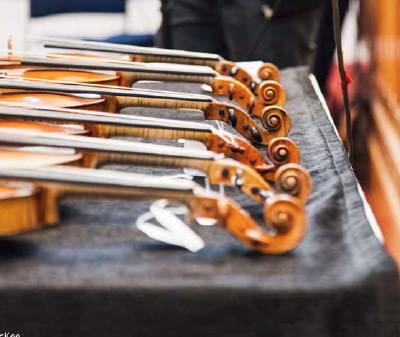Notable Sales: Domenico Montagnana
Domenico Montagnana moved to the great instrument-making centre of Venice around 1701, at the age of fifteen. Although Montagnana was almost certainly acquainted with Matteo Goffriller, Stefano Pio suggests that he learned his craft in the workshop of Matteo Sellas, before establishing his own shop in 1712.
Montagnana’s early violins show Stainer’s influence, which was prevalent at the time. This is evident in the flowing f-holes and high archings of the 1721 violin. From about 1730 his models broadened, the archings flattened, and overall his work became more Italian in character. These later instruments make fine solo instruments, and the 1731 violin is typical of Montagnana’s best work.
Montagnana’s cellos are his greatest legacy, and are considered by many to be the equal of Stradivari’s. During this period Venice was at the forefront of cello design, and Montagnana developed a short but exceptionally broad model that makes his cellos not only distinctive but also extremely successful as concert instruments. This model undoubtedly influenced G.B. Guadagnini as he developed his own cello model of similar proportions in the 1740s. Montagnana’s cellos share something of the reputation enjoyed by Guarneri del Gesù’s violins, retaining much of the quality of tone of a Stradivari, but tending to produce a more penetrating sound.
The double bass of circa 1747 dates from the last period of Montagnana’s life, and is one of only three known surviving examples.
(b Lendinara, 1686; d Venice, 1750)
Domenico Montagnana moved to the great instrument-making centre of Venice around 1701, at the age of fifteen. Although Montagnana was almost certainly acquainted with Matteo Goffriller, Stefano Pio suggests that he learned his craft in the workshop of Matteo Sellas, before establishing his own shop in 1712.
Montagnana’s early violins show Stainer’s influence, which was prevalent at the time. This is evident in the flowing f-holes and high archings of the 1721 violin. From about 1730 his models broadened, the archings flattened, and overall his work became more Italian in character. These later instruments make fine solo instruments, and the... Read more
27 January 2023 - Dilworth, John
This exploration of the breadth of the Rosenberg collection takes us next to Venice, itself the home of perhaps the richest diversity of violin makers in its prime period. There is a less clearly defined linear or chronological development... Read more
19 April 2021 - Dilworth, John
The Evolution of Violin Making from 16th-20th Century Part III
We offer buyers and sellers a bespoke private sale service, sourcing exceptional instruments and bows and matching them with the most discerning buyers.
More InformationTim Ingles and Paul Hayday will offer an initial evaluation of the authenticity and value of your instrument or bow to recommend an auction estimate and reserve price.
Enquire
Tim Ingles and Paul Hayday will offer an initial evaluation of the authenticity and value of your instrument or bow. At this stage, the assessment is free and without obligation. In the first instance, we suggest submitting good-quality images to us, preferably by email to info@ingleshayday.com or by completing the valuation form.
Read more